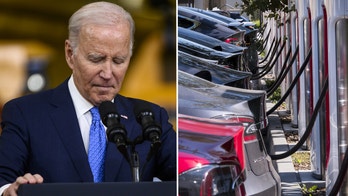
Jan. 29, 2015: Robots are remotely controlled to to handle inert simulated chemical munitions used for training at the Pueblo Chemical Depot, east of Pueblo, in southern Colorado. (AP)
The United States is set to begin destroying its largest remaining stockpile of chemical-laden artillery shells, marking a milestone in the campaign to eradicate the debilitating weapon from war.
The Pueblo Chemical Depot in Colorado plans to start neutralizing 2,600 tons of aging mustard agent starting in March. Ridding of the chemical weapon complies with a 1997 treaty banning all chemical weapons.
"The start of Pueblo is an enormous step forward to a world free of chemical weapons," said Paul Walker, who has tracked chemical warfare for more than 20 years, first as a U.S. House of Representatives staffer and currently with Green Cross International, which advocates on issues of security, poverty and the environment.
The work to neutralize the mustard agent starts less than a year after it was determined that chlorine gas killed 13 people in Syria in April 2014. Before the chlorine gas attack, a 2013 nerve gas attack killed 1,400 in Syria.
Pueblo has about 780,000 shells containing mustard agent, which can maim or kill, blistering skin, scarring eyes and inflaming airways. Mustard agent is a thick liquid, not a gas as commonly believed. It's colorless and almost odorless but got its name because impurities made early versions smell like mustard.
After nightmarish gas attacks in World War I, a 1925 treaty barred the use of chemical weapons, and the 1997 Chemical Weapons Convention set a 2012 deadline to eradicate them. Four nations that acknowledged having chemical weapons have missed the deadline: the U.S., Russia, Libya and Iraq.
Experts say the cost of destroying the gas and concerns about public health and the environment have slowed the process.
Coloradans have worried about mercury vapor from incineration, said Irene Kornelly, a member of the Pueblo Citizens Advisory Commission, a liaison group established by Congress. The opposition in Colorado and in Kentucky, where chemical weapons are stored at the Blue Grass Army Depot in Richmond, prompted Congress to order alternatives.
The Army will use two methods for the Pueblo stockpile. In March, the first of an estimated 1,400 shells that are leaking or otherwise damaged will be placed in a sealed steel chamber with walls up to 9 inches thick. Explosives will tear open the shells, and the mustard agent will be neutralized with chemicals.
The remaining hundreds of thousands of shells will be run through a partially automated, $4.5 billion plant starting in December or January. It will dismantle the shells, neutralize the mustard agent in water, and then add bacteria to digest and convert the remaining chemicals. The end product can be disposed of at a hazardous waste dump.
Pueblo expects to finish the job in 2019, while Blue Grass will not start the process of destroying the agents until 2016 or 2017 and finishing in 2013, Army spokeswoman Kathy DeWeese said. Overall, it is costing $11 billion to destroy the remaining chemical weapons.
The U.S. has totaled 30,600 tons of chemical weapons, both mustard and deadly nerve agents. Most of it was acquired during the Cold War. The U.S. has never used them in war.
Nearly 90 percent of the U.S. stockplie has been eliminated at depots in Alabama, Arkansas, Indiana, Maryland, Oregon, Utah and Johnson Atoll in the Pacific.
The Associated Press contributed to this report




